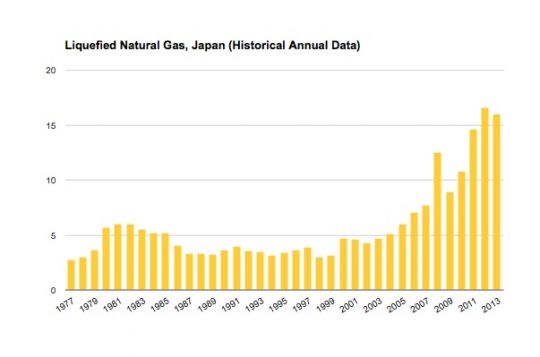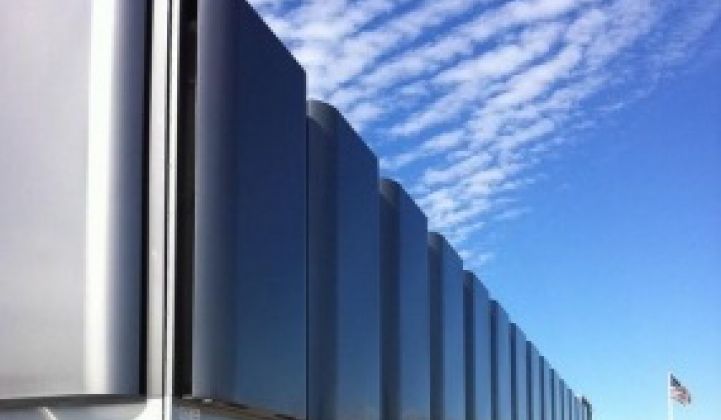Japan's SoftBank and Bloom Energy have formed a fuel cell joint venture, Bloom Energy Japan Limited, which will sell electricity from Bloom's natural-gas-powered fuel cells.
A release from the firms notes that there is "a significant electrical power deficit in Japan" and that "energy imports have greatly expanded Japan's trade deficit, while consumer electricity prices have recently risen by double digits."
The New York Times reports that Masayoshi Son, SoftBank’s CEO, had visited Bloom late last year, writing, "Mr. Son was convinced that Bloom’s sleek fuel cells were a perfect fit for Japan, [which is] energy-poor and made even more so by an almost complete shutdown of its nuclear energy program after the 2011 Fukushima disaster."
The joint venture is small by the standards of the two firms -- each firm will invest $10 million in an enterprise "that would sell Japanese corporations electricity generated by fuel cells." That language sounds as if the JV is more about selling electricity in power purchase agreement-form rather than outright sales of fuel cells. (We've asked Bloom to clarify.)
Last week we reported that Bloom Energy had begun to build fuel cells in its factory in Delaware, a former Chrysler factory in which Bob Marley once worked as a nightshift forklift operator. The factory in Newark, Delaware recently began shipping Bloom Boxes to two substation sites in Delmarva Power's utility territory.
Bloom's fuel cells are of the solid-oxide variety, which produce electrical power from natural gas via an electrochemical reaction rather than burning the gas. There is no heat resource in the Bloom Box as in other CHP fuel cells.The 200-kilowatt units are intended for commercial and industrial applications, and the firm boasts an all-star list of customers, including Adobe, FedEx, Staples, Google, Coca-Cola, Wal-Mart and Apple, which is tapping Bloom for 4.8 megawatts of fuel cells.
Bloom has raised almost $1 billion in venture capital over a decade from investors including GSV Capital, Apex Venture Partners, DAG Ventures, Kleiner Perkins Caufield & Byers, Mobius Venture Capital, Madrone Capital, New Enterprise Associates, SunBridge Partners, Advanced Equities, and Goldman Sachs.
Bloom Energy has suggested that it will turn a profit in 2013. Scott Sandell, a partner at NEA and Bloom board member, was quoted by Reuters as saying that Bloom will likely attempt an IPO late this year or early next. Sandell is/was a board member of SolFocus, Fisker Automotive and HelioVolt.
Bloom's fuel -- natural gas -- is a commodity and subject to price increases. Bloom's business has relied on state subsidies for distributed energy, but subsidies expire. The long-term reliability of the fuel cell stack remains a risk, and some have doubted Bloom's green claims and employment practices.
This is the first foray into international markets for Bloom. One difference for Bloom Server owners, not mentioned in the release or the Times article, is the price of natural gas in the U.S. versus the price in Japan. This surely impacts the pricing of electrical power from the Bloom fuel cell, as the following charts suggest.

Japan chart from MongaBay.com
While Bloom's JV is looking to replace idled nuclear plants with fuel cells, Japan's solar industry is also looking to fill that gap.
Before the Fukushima nuclear disaster, Japan had about 50 gigawatts of electrical capacity from 50 nuclear reactors. Just two of those reactors have been restarted -- but others will come on-line as they pass safety checks. Nuclear business, jobs, and politics will likely trump anti-nuclear sentiment in Japan.
While those reactors are offline, Japan makes up for the loss of 25 percent of its baseload power with fossil fuel imports, along with utility rate increases to pay for the fuel.
If solar is to help make up the shortfall, then the Japanese PV market will have to field unprecedented growth. And 2013 looks to be an impressive start to that growth curve. With about 1.7 gigawatts shipped in the first quarter of the year, the Japanese market is expected to reach 5.3 gigawatts in 2013 with the potential to surprise on the upside to 6.1 gigawatts, according to GTM Research. That puts Japan in a position to eclipse Italy and Germany and slip into the second spot behind new global solar market leader China.
This growth is driven by Japan's relatively high 38 cents per kilowatt-hour feed-in tariff (FIT) with a ten-year term for small rooftops and twenty years for larger installations.



